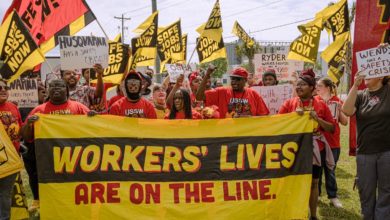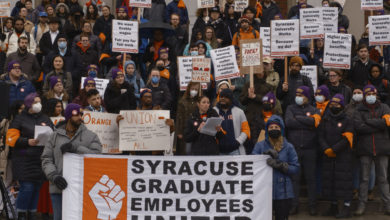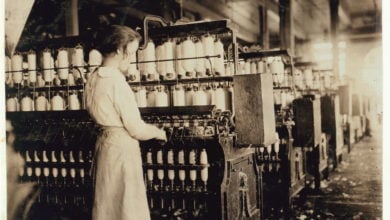In two recent community forums, Syracuse residents have confronted the City Police Department about its plan to install nine high-tech surveillance cameras in the city’s Near Westside, a predominately Latino and working-class neighborhood. Initially, the police had absolutely no intention of going into the community to speak with residents about the proposal; they had been advancing their plan behind closed doors. They only participated in the forums after being pressured by community groups and progressive organizations.
The police attempted to make the meetings into an ineffective show: they publicized them little and did not inform the media. It was only an intervention by the ANSWER Coalition (Act Now to Stop War and End Racism) and the League of United Latin American Citizens that brought out community members and the Post-Standard daily newspaper. Over 60 residents attended the first forum, on Oct. 15, to speak out about the cameras.
The police proposal, a “pilot” program with no end date, was thoroughly criticized by nearly every participant. It was only 10 minutes into the police department’s presentation when the first interruption occurred. As the police were talking about how gunshots fired are underreported to the police, Westside resident Gary Bonaparte spoke up, saying “People are afraid to call the police because they’re afraid that, if they do, they’ll get their ass kicked.”
Out of the dozens of people that spoke out at the meeting, only two individuals supported the cameras without reservations. The overwhelming majority of the people there, including many people speaking for groups with constituencies, were either against the cameras or, at the very least, had serious concerns about them.
Police propaganda: setting the record straight
Police departments always claim that surveillance cameras will “make neighborhoods safer.” However, they almost always use anecdotal evidence and single studies, both of which are remarkably deceptive.
Single studies can be inaccurate when they fail to take into account other variables, such as location and lighting, on the effect of cameras on violent crime. Then there is the problem of displacement: crime can easily move from a street with surveillance cameras to a street without them.
The most reliable statistics come from meta-analyses, that is, large analyses of data from multiple studies utilizing similar methodologies and hypotheses. Based on meta-analyses, Noam Biale, of the ACLU Technology and Liberty program, has found that “ CCTV [closed-circuit television] is found to have no statistically significant impact on crime rates at all” (ACLU, Expert Findings on Surveillance Cameras).
On top of that, the cameras, which have constant flashing blue lights, serve to divide cities and isolate communities by labeling some parts as so-called high-crime areas. Sterling Boston, who is president of his public housing unit, told police officials that he sees “the cameras as a weapon being used against the community.”
The fact of the matter is that crime is relatively independent of how many police are on the street or what kind of technology they have. The police function in society to preserve the economic and social order, that is, the rule of the banks and bosses. When material and economic factors that contribute to crime are considered, it becomes clear that the biggest perpetrator of crime is the very rule of the banks and bosses!
Community speaks up
Marty Yunggebauer, another Westside resident, said that “the cameras make me feel like my son is going to grow up in a police state.” She told the police department that a lot of the problems in the neighborhood are the result of the way the police operate there. The first meeting took place on Shonnard St., which is where Raul Pinet Jr. was beaten brutally by police officers just two months ago. Pinet died in jail the same day, and the city coroner has ruled his death a homicide.
Syracuse, like so many other cities, has a long history of police brutality, and oppressed communities suffer the most. African Americans and Latinos are targeted for stops, searches, violent arrests, and beatings. Police surveillance cameras would be another tool for the police to use in repressing the most oppressed sectors of the city.
The police also spend a lot of time harassing people, especially youth, for hanging out in public areas. First Deputy Chief David Barrette boasted of the camera system’s effectiveness in “deterring public nuisance crimes.” Prison rights advocate Kathleen Rumpf responded by clarifying that those engaged in so-called “public nuisance” crimes are oftentimes “just living life.”
Many residents complained that police routinely speed through stop signs and speed up as they pass children playing in the street. Several people commented on the harmful effect that the police, who sit in black, unmarked cars, have on neighborhood children.
In an attempt to silence some audience members, Syracuse Common Councilor Patrick Hogan, who represents the district, asked for a show of hands as to who technically resides in the Near Westside. Luz Encarnacion, president of LULAC, called out the absurdity of the tactic, saying, “I don’t live on the Westside but these are my people… When there is a problem in the community people call Luz Encarnacion.”
Hogan’s point was further discredited by the fact that the SCPD has plans to install 5 additional cameras on the Southside, and that they look to Rochester, NY, which has 140 surveillance cameras, as a model. Still, at the second meeting, which took place on Oct. 19, Police Chief Frank Fowler tried the same tactic. Fowler was later forced to apologize for being rude.
After that meeting ended, LULAC member Ruth Beltran stated that “the police’s response was… one of making excuses and trying to minimize the community’s concerns.” Indeed, the police officials were markedly evasive, condescending, and at times dismissive. It was clear that neither meeting had gone the way they anticipated.
On Oct. 27, the ANSWER Coalition and LULAC are holding a rally to demand: NO SURVEILLANCE CAMERAS IN OUR CITY! and COMMUNITY CONTROL OVER THE POLICE! The demonstration will take place in front of the Spanish Action League, on the 700 block of Oswego Street. Email [email protected] or call 315-491-6987 for more information or to help volunteer.
We need jobs, education, housing and healthcare! NOT a police state!






